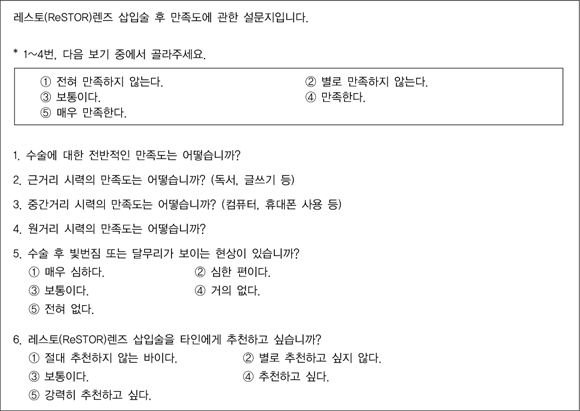Abstract
Purpose
Methods
Results
Figures and Tables
Table 1

Values are given as mean ± SD or number.
D1 = SN6AD1(AcrySof® IQ ReSTOR® Aspheric IOL, Alcon Lab., Fort Worth, TX, USA); D3 = SN6AD3(AcrySof® IQ ReSTOR® Aspheric IOL, Alcon Lab., Fort Worth, TX, USA).
UDVA = uncorrected distance visual acuity; BDVA = best corrected distance visual acuity.
*Mann-Whitney U-test; †Astigmatism: measured by ORB scan (Bausch & Lomb, Rochester, NY, USA).
Table 2

Values are given as mean ± SD.
D1 = SN6AD1(AcrySof® IQ ReSTOR® Aspheric IOL, Alcon Lab., Fort Worth, TX, USA); D3 = SN6AD3(AcrySof® IQ ReSTOR® Aspheric IOL, Alcon Lab., Fort Worth, TX, USA).
UDVA = uncorrected distance visual acuity; BDVA = best-corrected distance visual acuity; UIVA = uncorrected intermediate visual acuity; UNVA = uncorrected near visual acuity.
*Mann-Whitney U-test.
Table 4

Values are given as mean ± SD or number.
D1 = SN6AD1(AcrySof® IQ ReSTOR® Aspheric IOL, Alcon Lab., Fort Worth, TX, USA); D3 = SN6AD3(AcrySof® IQ ReSTOR® Aspheric IOL, Alcon Lab., Fort Worth, TX, USA).
UDVA = uncorrected distance visual acuity; BDVA = best corrected distance visual acuity.
*Kruskal-Wallis test; †Astigmatism: measured by ORB scan (Bausch & Lomb, Rochester, NY, USA).
Table 5

Values are given as mean ± SD.
D1 = SN6AD1(AcrySof® IQ ReSTOR® Aspheric IOL, Alcon Lab., Fort Worth, TX, USA); D3 = SN6AD3(AcrySof® IQ ReSTOR® Aspheric IOL, Alcon Lab., Fort Worth, TX, USA).
UDVA = uncorrected distance visual acuity; BDVA = best-corrected distance visual acuity; UIVA = uncorrected intermediate visual acuity; UNVA = uncorrected near visual acuity.
*Kruskal-Wallis test, Tukey's post hoc test; †D1/D1 vs. D1/D3, p = 0.024; D1/D1 vs. D3/D3, p = 0.005; D1/D3 vs. D3/D3, p = 0.338; ‡D1/D1 vs. D1/D3, p = 0.080; D1/D1 vs. D3/D3; p = 0.001; D1/D3 vs. D3/D3, p = 0.196.
Table 6

Values are given as mean ± SD.
D1 = SN6AD1(AcrySof® IQ ReSTOR® Aspheric IOL, Alcon Lab., Fort Worth, TX, USA); D3 = SN6AD3(AcrySof® IQ ReSTOR® Aspheric IOL, Alcon Lab., Fort Worth, TX, USA).
*Satisfaction score: score measured by Likert scale; †Kruskal-Wallis test, Tukey's post hoc test; ‡D1/D1 vs. D1/D3, p = 0.144; D1/D1 vs. D3/D3, p = 0.005; D1/D3 vs. D3/D3, p = 0.320; §D1/D1 vs. D1/D3, p = 0.014; D1/D1 vs. D3/D3, p < 0.001; D1/D3 vs. D3/D3, p = 0.246; ∥D1/D1 vs. D1/D3, p = 0.049; D1/D1 vs. D3/D3, p = 0.004; D1/D3 vs. D3/D3, p = 0.568.




 PDF
PDF ePub
ePub Citation
Citation Print
Print




 XML Download
XML Download